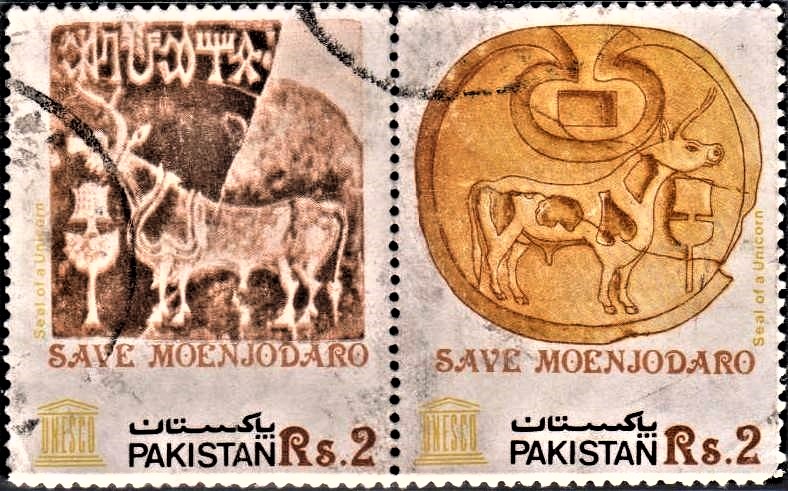
Pakistan on Save Moenjodaro 1984
Complete set of 2 nos. of commemorative postage stamp on the UNESCO World Heritage Campaign of Mohenjo Daro :
 Issued by Pakistan
Issued by Pakistan
Issued on Dec 31, 1984
Issued for : Now, Pakistan Post Office is issuing, on December 31, 1984, two special postage stamps of the denomination of Rs. 2/- each on Moenjodaro, in the World Heritage Monument series, as a part of “Save Moenjodaro” Campaign.
Designer : Adil Salahuddin & M. A. Munnawar (PSPC)
Type : Se–tenant set of 2 Stamps, Postal Used
Denominations : Rs. 2/- each design
Colours : Dark brown, reddish brown, light brown, & yellow ochre
Size of stamps : 33.10 x 41 mm
Size of print : 29.10 x 37 mm
Perforation : 13 x 13½ C
Quantities : 500,000 each denomination
Number of stamps in a sheet : 60 (Sixty) 30 (thirty) each design (se-tenant)
Process of printing : Litho Offset
Printers : Pakistan Security Printing Corporation
About :
- The dead city of Moenjodaro is located on the right bank of the Indus River, about 400 Kilometers North of Karachi. The remarkable discovery of Moenjodaro in 1922 was at first nothing more than the result of routine explorations by the Archaeological Survey of British India, regarding twin mounds, one large & the other small, in the district of Larkana, about 12 Kilometers east of the small town of Dokri.
- The excavations conducted in the subsequent years established that a civilization possessing a high standard of art & craftsmanship & a well developed system of pictographic writing had existed about 2250 B.C., in the Indus Valley for a considerable period before the arrival of Indo-Aryans. Moenjodaro and other sites of Indus Valley have provided very significant archaeological results and given us considerable information about the civilization of the original inhabitants of the sub-continent.
- The excavated ruins at Moenjodaro, which have so far been subjected to the attention of archaeologists, cover an area of about 100 hectares.
- Well-constructed and covered drainage systems and neat parallel streets, laid out in an orderly design, suggest a developed and major civilization, far ahead of most of the rest of the ancient world. Europe at the time, more than 4,500 years ago, had barely emerged from the Stone Age. Moenjodaro, however, yields its secrets reluctantly. It will be sometime before a really comprehensive picture of the life of the people begins to emerge.
- The economy of the cities of Moenjodaro was based upon the fertile valleys of the major rivers of the Indus Basin & the easy means of communication and transportation which these rivers afforded. As such, agriculture was the main occupation of the people of these regions. There is evidence to show that wheat, barley, sesamum, dates and cotton were cultivated. The farmers depended on the annual rains and floods for the irrigation of their fields. The architecture of the Moenjodaro period is plain & utilitarian. There are neither imposing temples nor royal tombs. It seems that the aim of the city builders was to make life comfortable rather than luxurious. No definite answer can be given to the question, as to who were the people who lived in Moenjodaro. But it is certain that they were of non-Aryan racial stock and highly civilized.
- Among the causes for the decay and desertion of these ancient cities of Indus Valley Civilization after 1800 B.C., progressive desiccation of the Valley may have been one. Another possibility may be the growing danger of floods which compelled the inhabitants to evacuate these cities. There was a remarkable dearth of weapons of defence and war and it is probable that those rich cities with their un-warlike mercantile population were either ransacked by the invading tribes from the neighbouring hilly regions or that the inhabitants were compelled to migrate to more fertile valleys when dry & arid climatic conditions started prevailing on the Indus Valley.
- It is a paradox of facts that the ruins of Moenjodaro buried beneath the accumulations of five thousand years remained in an excellent state of preservation. But as soon as they were exposed from oblivion to the incredible gaze of the 20th Century, they were overtaken by water-logging and salinity. These two diseases, combined with the threat of bank erosion by the Indus River, pose a grim danger to the existence of one of the most valuable cultural legacies of the human race.
- Measures to Save Moenjodaro have been devised by the Government of Pakistan with the help of UNESCO experts. As a part of an international appeal for assistance to preserve Moenjodaro, the Pakistan Post Office, in collaboration with the Authority for the Preservation of Moenjodaro (Pakistan), had arranged to bring out a series of special stamps for public motivation. The first issue of the “Save Moenjodaro” series, consisting of a set of five stamps in se-tenant, was brought out on 29th February, 1976. This was followed by a 20-Paisa stamp issued on 31st May, 1976 and a 65-Paisa stamp issued on 31st August, 1976. Earlier, on 16th September, 1963, a set of four stamps was issued on Archaeological Series, out of which one 13 Paisa stamp depicted Moenjodaro.
- Issued by: The Director General, Pakistan Post Office, Islamabad.


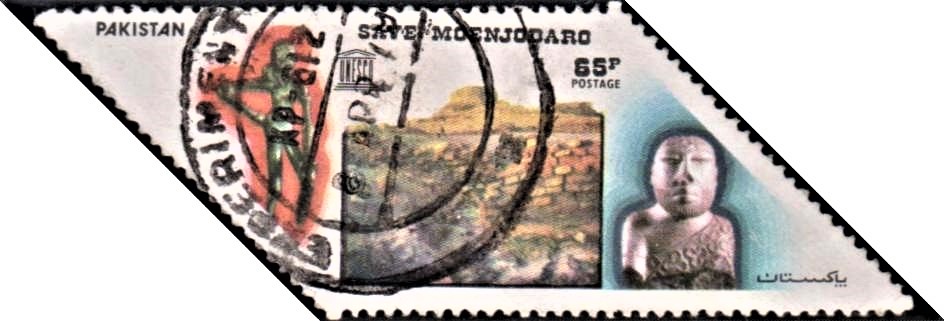
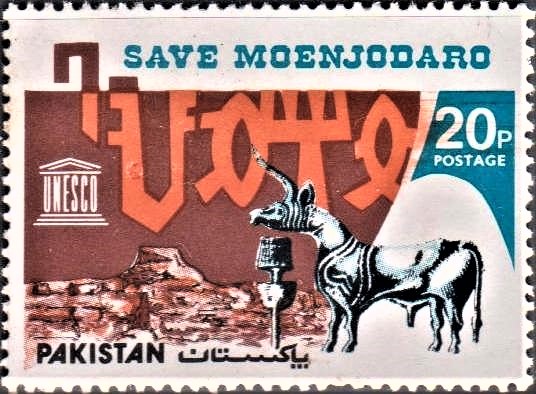
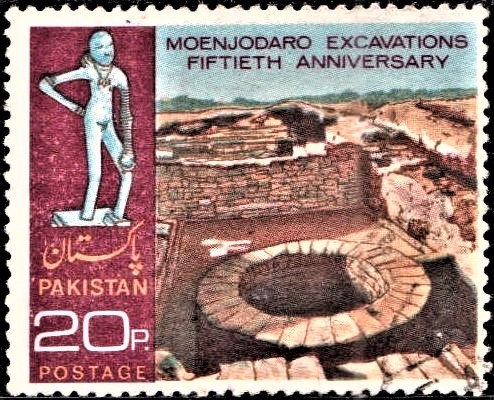
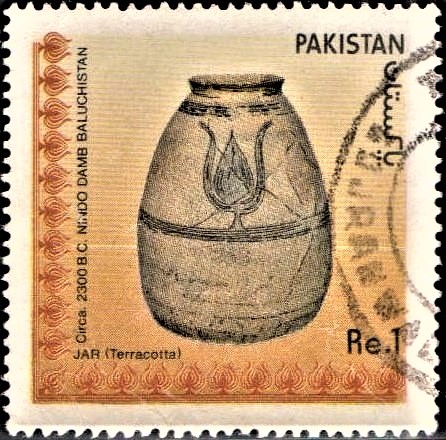
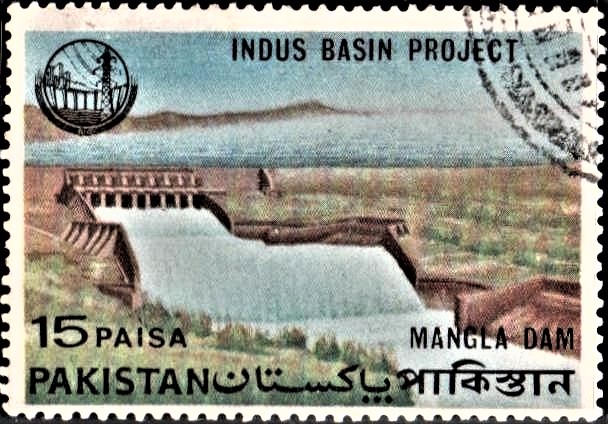
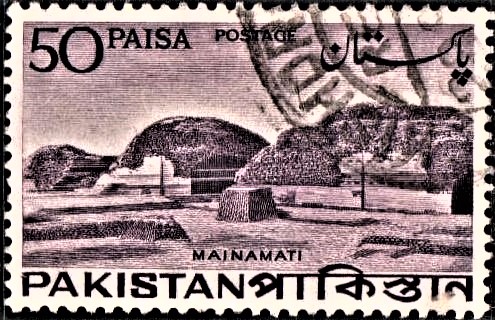
[…] are the archaeological remains of the oldest known civilization of the world at Moenjodaro and Taxila – such spots of tourist attraction as Swat and valley of Kaghan which excel in […]
[…] and kitchen implements made of coral and mussel shell, discovered during excavations at Harappa and Mohenjo–Daro, bear testimony that Indians were master seafarers as early as five millennia ago. Buddhist […]